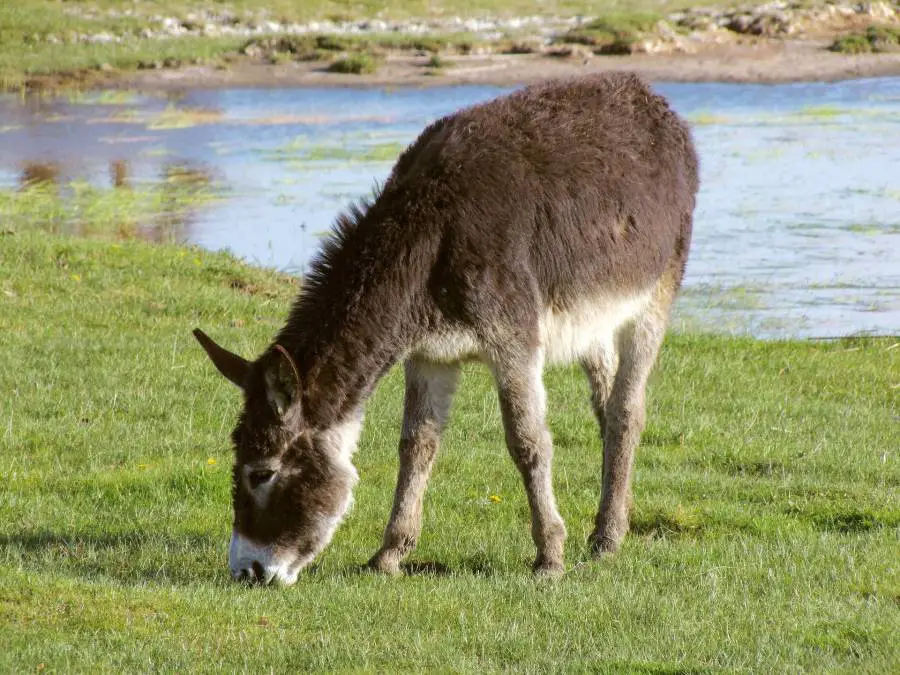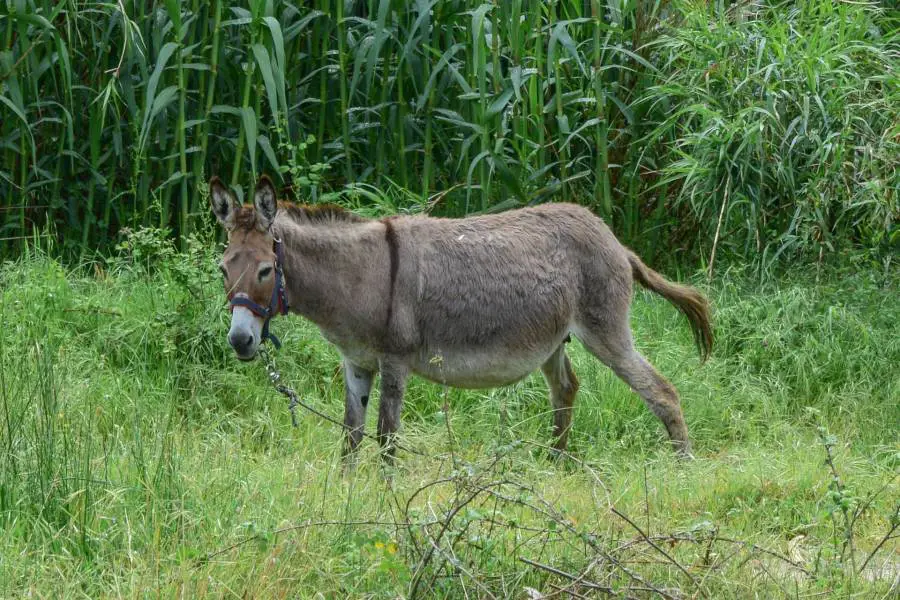Table of Contents
Most donkey hoof problems can be traced to death or inadequate living conditions.

A dirty environment encourages the growth of germs and fungi, which puts donkeys at risk for various ailments, including those that affect their hooves.
The bottoms of a horse’s feet are cone-shaped and narrower than the bottoms of a donkey’s feet, which are more robust and can hold more water.
These damp feet are the root of the donkey hoof problem. The most prevalent issues and how to treat them, as well as how to avoid them, are detailed below.
Keep reading!
1. Laminitis
Laminitis is a painful condition that causes extreme pain in donkeys. Additionally, it may have irreversible implications.
As a result of the destruction of the toe bone’s support system in the hoof, the toe bone may no longer be able to migrate downward or rotate.
When the toe bone loses its place, irregular hoof growth and a change in the hoof’s angle are more likely to occur.
This consequence of the disintegration of the toe bone support system is what makes laminitis so excruciatingly painful.
Numerous factors can induce laminitis; cold, metabolic, and hormonal diseases are some of those factors.
Symptoms
- The donkey will be unwilling to walk.
- The reluctance of the donkey to turn and raise their feet.
- The donkey would lie more than usual.
- The donkey shifts weight from foot to foot.
- The pulses in the blood vessel around the fetlock of the donkey would be effortlessly felt.
- The donkey hoof will be filled with horizontal ridges.
Treatments
- Use radiographs for monitoring while you trim the affected foot often. If no radiographs are available, use your thumb to apply pressure as you trim.
- While in the course of treatment, pad the entire sole of the affected foot with cotton wool and bandages.
- Give the donkey rim shoes to support its movement.
- Provide deep, supportive bedding with materials like sand, sawdust, and gravel. The bedding can be supported with Styrofoam for more comfort.
- Give cold therapy to the feet of the donkey to reduce the pain and inflammation. This therapy should not be given to donkeys who catch laminitis from a cold.
It is a wise thing, however, to call the Veterinary doctor before any of the above is carried out.
Before the vet arrives, let your donkey be in its preferred position and give it easy access to food and water.
Preventive Measures
- Always examine your donkey’s hoof keenly.
- Put your donkey on a lot of active engagements frequently.
- Avoid giving your donkey sweet and concentrated food. Instead, let this be replaced with quality hay.
- Watch the weight of your donkey, as a heavier one would pressure the delicate feet of the donkey. It is also well-known that overweight donkeys are more prone to various conditions.
2. Seedy Toe
Poor hygiene significantly contributes to seedy toe infection, also known as white line disease.
This white line allows foreign objects and microorganisms to enter and cause or worsen donkey hoof infection.
When a donkey contracts this disease, the area where the white line appears becomes severely weakened.
Fungus feeds on the white line, weakening it to the interior of the hoof wall.
The seedy toe lesions are not particularly painful. However, the donkey will suffer severe pain if an object or dirt becomes lodged in the horny part of the hoof.
When this disease is not treated, the foot becomes painful and unstable.
Symptoms And Treatments
This disease usually does not come with lameness unless an underlying infection or chronic laminitis occurs.
However, it can be noticed when a cavity is found along the white line of the donkey, usually at the toe.
If you do not clean your donkey hoof, you will likely not notice this disease until it is grown.
Treatments
The best way to treat a seedy toe is to attack it before it gets bad. It could be done by using medicine or cutting away the infected part.
- A farrier should cut off the affected part from the hoof wall to allow the healthy hoof to regrow.
- Feed the donkey with supplements containing zinc and biotin, and methionine.
- After cutting off the affected area, cover the hole left with a mix of copper sulfate, vaseline, a small plug of cotton wool, and diatomaceous earth.
- Do not cover the hoof with rims or hoof boots containing a solution of copper sulfate. Exposure is vital for a lower rate of infection.
The veterinary doctor should also be involved as the farrier does their work, so instability of the hoof will be avoided. Also, seek advice from the vet if the problem persists.

Preventive Measures
The donkey should be kept on clean and dry grounds. This measure should be carried out often while the donkey is still whole.
It should also be carried out after a seedy toe infection has been treated until the donkey is fully recovered.
3. Foot Abscesses
Before a foot abscess occurs, there must have been a wound that penetrates the donkey’s hoof or white line.
When the wound becomes infected and pus builds up, then the abscess of developed.
Often, these wounds would not be noticed, except if you spend time checking the hoof of your donkey.
Your donkey can get these wounds from maybe a sharp glass, a piece of tin, or a nail unearthed when the donkey is scratching a hole in the dirt.
The foot abscess is a very painful one, and it requires urgent veterinary attention.
Symptoms
- The donkey begins to limp or behave in a different funny way.
- When the donkey hoof is quite delicate.
Treatments
- Consult the vet doctor.
- You can get a poultice to help draw out the infection from the foot if you do not want to wait for a vet. It is what most veterinary doctors would recommend anyways.
- Use a hoof knife to cut away the abscess. It will help the infection drain out.
Preventive Measures
- Apply hardener to the donkey hoof before extreme weather changes.
- Remove foreign objects from your donkey’s area.
- You should contact your vet for more, but you can also vaccinate your donkey while waiting for a response.
4. Tetanus
It is similar to the Foot abscess but different because the tetanus infection is a secondary one.
While the foot abscess is caused by wounds penetrating the white line of the hoof, tetanus happens when the wounds become infected and pus buildup.
Tetanus is a bacterial infection that will travel through the bloodstream of the donkey to its nervous system to launch an attack.
The symptoms to look out for in this case are the same as that of the Foot Abscess. So also, are their treatments similar?
Preventive Measure
Giving your donkey some shots of an effective vaccine from your vet will protect the hoof from tetanus.
5. Thrush
Thrush is the name given to a yeast infection that affects the frog’s foot in particular. The triangular pad at the back of the donkey hoof is known as the frog of the foot.
Like many yeast infections, this thrush infection can be identified by its strong unpleasant odor.
Thrush infiltrates the donkey when it is exposed to wet terrains and conditions. Thrush can destroy your donkey hoof and cause lameness if it is not treated correctly.
Symptoms And Treatments
Unpleasant yeast smell from the donkey hoof when picking out the debris.
Treatments
- Pick and clean the hoof twice daily.
- Insert cotton balls soaked with the solution for hoof fungal infection into the hole created after cleaning the hoof.
Preventive Measure
Allow your donkey’s feet to dry out daily, and walking the donkey on firm, dry terrain is the best way to prevent this infection.
Also, feed your donkey on a dry stall or concrete ground.
Conclusion
Most donkeys require a hoof trimming every 5-10 weeks, rather than the twice-a-year prescribed by many. It is essential to check your donkey hoof frequently.
Doing this will help you know if there is an infection to treat or a trimming to be done before it gets worse.
Many of the donkey hoof diseases would be prevented if you could care for your donkeys by keeping them in clean, dry areas, feeding them appropriately, and checking their hoofs from time to time.
